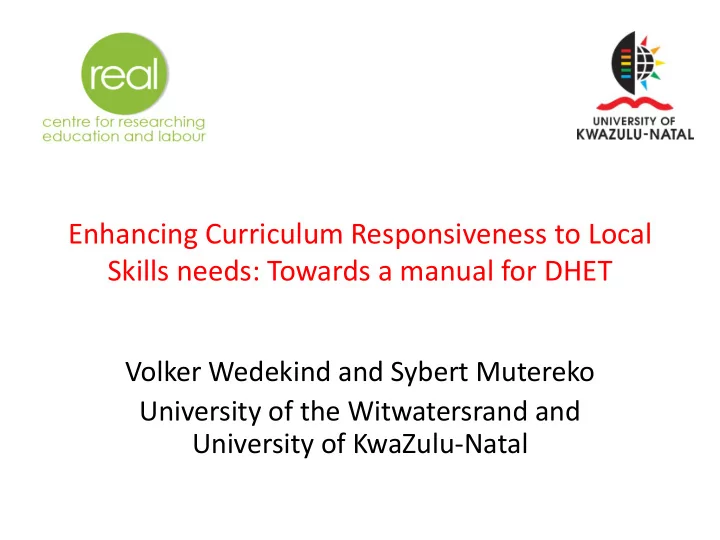

Enhancing Curriculum Responsiveness to Local Skills needs: Towards a manual for DHET Volker Wedekind and Sybert Mutereko University of the Witwatersrand and University of KwaZulu-Natal
OUTLINE • What is the problem? • Tensions between central and local • International trends • What is currently possible? • Developing a progressively responsive model • Alignment with Centres of Specialisation • Going forward
What is the problem? PART ONE
Responsiveness • Employers’ needs vary depending on company, locality and industry • Students’ needs vary depending on a range of individual, local and regional factors – Diversity – Language – Prior schooling • Qualifications and their curriculum are centrally determined, assessment is managed centrally and textbooks are standardised
In a nutshell … • Colleges and their lecturers have to manage a tension between local specificities (based on student, employer and community/environmental needs) and national and international demands for standardisation
Tensions Local National and Global • Local contexts require • Standards should conform specific focus areas that to national and may not be relevant international norms to elsewhere ensure transferability • Lecturers are best equipped • Quality concerns related to to make holistic judgments local assessment results in about student competence national standardised assessment
International Trends
Australian competency based TVET
Chinese TVET • The curriculum is divided into three parts o About one third for general academic o skills defined nationally by the ministry of education. o Another third is defined nationally associated with the particular occupation. o The final third, also in the occupational field, determined locally according to local needs sometimes at school level. o Vocationalism ” and “localism” Chine TVET
GERMANY TVET Source: Aenis and Lixia, 2016
Ethiopian outcome-based TVET
Common features • A common framework. • Curriculum decentralisation to industry, occupation, business and geographic regions. • Quality assurance.
What is Currently Possible? PART TWO
Classroom autonomy • All teachers, even within the most restrictive curriculum, have space to add, make strategic selections and enrich the curriculum – Lecturers may need support through professional development activities to enhance this capability • Lecturers can develop their own materials or use existing materials that are not prescribed • Extra curricula activities, practicals and work exposure • Gaps and additional areas not covered can be pointed out to students
Industry Linkages • Colleges and lecturers are already being encouraged to develop strong industry linkages • Lecturers are being exposed to work-places • Industry are making resources available either through donations, staff time or site visits
A Process for Greater Curriculum Autonomy PART THREE
Options • A completely decentralised model where curriculum and assessment determined at local level (similar to universities) • A centralised model with clear components that can be varied at college level • A centralised model which takes greater account of industry and other drivers of responsiveness
A Proposal • Build on concept of Centres of Specialisation • Designate a Programme Convenor College based on COS – Requires support from College Council – Based on sustained expertise and demonstrated linkages to industry • Convenor hosts annual meeting with all programme leaders from participating colleges – Includes appointed national examiner and regional DHET staff
A Proposal cont. • National Forum will examine curriculum and determine what is core, what needs to be examined nationally and where variations may be allowed • Criteria for the assessment of CAT determined • Employer bodies invited to participate in Forum, along with appropriate SETA and QCTO/Umalusi • Individual colleges link to employers and provide feedback to National Forum with support from SETAs
A Proposal cont. • National Forum provides guidelines to colleges on accommodating variations • As far as possible, staff from the colleges should be involved in the national marking process and provide direct input into the examination process. • The CAT component should be moderated and interrogated through regional and national clusters • Colleges that are not COS/COE but have human and other resources that make it appropriate to involve them in the process can apply to join the process.
What is Needed? • The definition of Centres of Specialisation and Centres of excellence needs to be adjusted to include this role • A pilot programme should be identified • QCTO, Umalusi and SETAs need to be consulted on their role • Activities of the Convenor and Forum need to be aligned to the policy on professional development • DHET examiners need to be brought on board
Financial Implications • The costs of a national meeting and local meetings need to be budgeted for – Suggest relevant SETA funds national meeting and regional meetings covered by colleges • Including staff in assessment processes and moderation needs to be costed and budgeted
Monitoring and Evaluation • Pilot scheme to be fully studied before this is rolled out further • Can be restricted to a limited number of colleges while processes are developed • Service provider should be appointed to do a full developmental evaluation
We would welcome as much feedback as possible! Thank you!
Recommend
More recommend